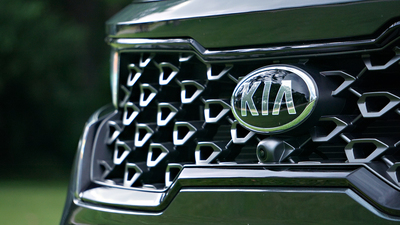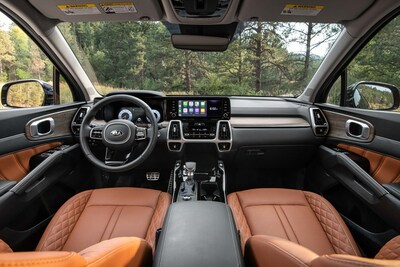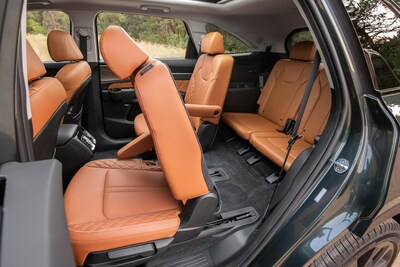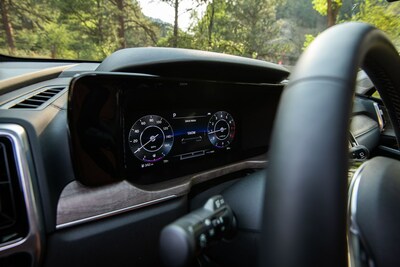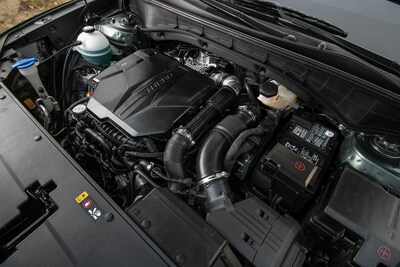2021 Kia Sorento X-Line AWD - Review by Rex Roy
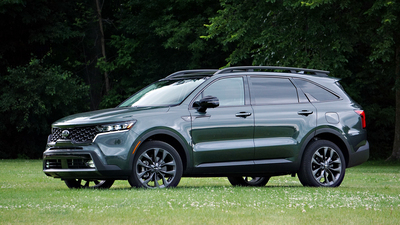 |
2021 Sorento X-Line AWD it's just what you’d expect from today's Kia.
By Rex Roy
Senior Editor
Michigan Bureau
The Auto Channel
Watching car companies develop over decades gives perspective about how said companies are run, and what’s important to them.
I’ve watched once-mighty companies become way less mighty (but no less full of hubris). I’ve followed the struggles of the old Chrysler Corporation as it fought back from the (seemingly perpetual) brink of disaster with shockingly strong products (think the 1994 Dodge Ram) only to succumb to purposeful management decisions (DaimlerChrysler, Cerberus, FCA, etc.) that dug the company’s own trench toward oblivion. I’ve pondered the decisions of Mitsubishi to squander their engineering edge (think counter rotating balance shafts or any of the decades of EVOs) by purposefully driving into a box canyon of not-yet-ready-for-prime-time-tech, hoisting a green flag, and being surprised nobody cared.
I’ve also watched Kia. Their cars of the 1990s weren’t great or particularly well styled, but they got better and better because management practically supported the brand by packing every vehicle with more shiny-object-features-for-a-low-price-than-the-competition while backing their products with HUGE warranties (10-year powertrain). They also fixed another major issue; the brand’s styling.
The SUV you’re reading about today is an excellent example of a long-term company vision realized. Kia – once a backmarker – is now a leader.
Kia loaned me their all-new 2021 Sorento X-Line AWD SUV for this evaluation. At first glance there’s nothing exceptional about its generic SUV profile, but as you take more than a 5-second look at the design, there’s so much about the proportions and stance that’s spot on, if not quite as perfect as its Telluride garage mate.
Kia’s been in the SUV game since the 1990s, and they know what they’re doing. In the mid-2000s, Kia hugely upped their design game when they hired an Italian designer – Massimo Frascella. The then young designer penned the 2007 Kue concept crossover, and it became a starting point for a design revolution at Kia. While Frascella moved on and is now the Creative Director at Land Rover, the Kia North American Design Studios continue to crank out stunningly good mass market interior and exterior designs that follow the lead Frascella and others perused.
Today, every vehicle’s profile is largely dictated by aerodynamics (well, not a Bollinger), dynamic safety targets, and dimensional hard points required by the interior package. These facts are why so many contemporary vehicles from different brands look so similar. Thankfully, the front and rear ends are spaces where designers have latitude for some fun. Proof of point, the Sorento’s dimensional grill is bold and stands out, in a good way.
There’s much more good design inside. Our tester’s 3-row interior featured a mix of soft-touch materials, leather, open-pore wood, and high-contrast LED screens that make even a jaded automotive journalist go, “This is nice.” The team didn’t overlook anything major like cupholders or the 2020-decade equivalents, USB charging ports. There are plenty of both for the first two rows. An afterthought on some vehicles, even the Sorento’s vent outlets are handsomely done.
A couple of details worth mentioning; the LED screens used for the UVO-branded NAV/entertainment and instrumentation include some clever use of the graphic real estate. The radio tuning display – instead of some lame interpretation of a linear tuning scale – uses a digital representation of totally analog Nixie tubes.
You’ll also note that the Sorento doesn’t have any conventional gauges. While the speedometer looks like a conventional gauge, it isn’t. Every aspect is animated. The tachometer is the same, and the instant-read digital nature accentuates the precise shifts (no torque converter, no slop) of the about-to-be-mentioned Dual Clutch Transmission (DCT) as the tacho needle crisply drops from one gear to the next.
The all-digital dash gave Kia designers the freedom to do some clever (if not necessary) things with the display. Like many vehicles today, the Sorento features a simulated 360° view around the vehicle to help with parking. It’s a nice feature when you’re trying to slide the truck into or out of a tight spot. Repurposing the side cameras, when the left turn signal is activated, the speedo gauge is replaced by a side view of the left curb. Ditto for the right side, only it replaces the tachometer. Frankly, I’ve never needed to “see” exactly where my wheels were as I was making a turn, but I did find the feature (and the view) strangely fascinating.
The Sorento’s safety alerts are plentiful and easy to get used to. Frankly, the incessance and urgency of all the beeping, steering wheel tingles and brake pedal vibrato annoy more than promulgate safety. (I’m a Boomer; pay attention, use the mirrors, and get off my $%#@ing lawn.)
Passenger utility/usefulness is something no reviewer needs to focus on these days. All vehicles are more than commercially acceptable with only minor differences in feature operation. As par for the course, our truck’s 2nd row featured comfortable captain’s chairs that offered plenty of room for any adult shy of a linebacker or basketball forward. These seats easily slid forward for 3rd row access, and room back there was adequate for kids and smaller adults. The 3rd row also effortlessly folded to expand the cargo volume from a few grocery bags to enough room for a garden center run.
And about that word “run,” this truck can. It used to be that a vehicle this size needed a small V8 or a big V6. Not today. The X-Line’s 2.5-liter four cylinder is turbocharged to 281 horsepower and a stout 311 lb.ft. of torque. The engine is smooth thanks to a now ubiquitous technology known as twin-counterrotating balance shafts (invented by Mitsubishi in the 1970s and licensed to everybody including Porsche).
The gearbox is an interesting choice for a mass market SUV … a dual-clutch. It delivers very precise … “snicky” … shifts that under part-throttle applications are so dynamically smooth that you hear them, not feel them. Under full throttle you feel the gearchange but they’re ripped off quickly, precisely and without any momentary fall off in juice.
Working together, the powertrain delivers powerful acceleration. There are some highway driving circumstances that require the turbo to spool up and the transmission to downshift, but overall, the drivability is excellent. My only complaint is that while the engine is smooth, there’s nothing that can be done to further refine the sound of a four cylinder. To these ears, the engine doesn’t sound as refined as everything else about this vehicle.
Our tester landed at my Detroit office in June, not exactly a season that offered much in the way of weather that required the X-Line’s all-wheel drive, lockable center differential, snow mode, or the chassis’ extra inch of suspension lift. I’m not going out of much of limb to guess that it probably works just fine.
Prepping to write this story, I read the introductory press release. It included some 17 acronyms; a freak’n alphabet soup of tech marketing jargon. Thanks to HDA, the SUV can even help you drive it, but consider the Highway Driving Assist feature a very aggressive lane keeping feature because it’s certainly no Auto Pilot or Super Cruise. (Kia doesn’t make that claim, but drunks trying to get home after last call may - don’t be that person.)
Bottom line: Do consider the 2021 Sorento if you’re looking for a 3-row SUV to handle daily life. It’s a good-looking, well-equipped, value-packed choice backed by a great warranty. In other words, exactly what you’d expect from Kia in 2021.
2021 Kia Sorento X-Line AWD Key Specificiations
- X-Line trim features 1.0-in. higher ground clearance, improved approach/departure angles, more advanced AWD with snow-mode and a more robust roof rack than outgoing Sorento
- Price as tested $44,290
- Three Row 4+2 or 5+2 Passengers
- Cargo (cubic feet) 75.5
- Engine:
-2.5L/4 -
-Horsepower 281 @5,800
-Torque 311 lb.-ft. @ 1,700 - 4,000 rpm - Transmission:8 Speed Dual Clutch (wet)
- EPA Mileage; city/highway/combined 21/28/24
- Max towing 3,500
Four engines are offered on the 2021 Sorento, including two internal combustion powerplants and two electrified motors in both front-wheel drive (FWD) and all-wheel drive (AWD) configurations:
- 2.5-liter GDI 4-cylinder
- 8-speed automatic transmission
- 191 horsepower and 181 lb.-ft. torque
- FWD or AWD
- AWD system uses torque-vectoring with center-locking differential to provide extra power to rear wheels in slippery conditions4
- Estimated combined (city and highway) 27 mpg (2 mpg increase over previous Sorento)
- 2.5-liter GDI 4-cylinder Turbo
- Segment exclusive 8-speed wet dual clutch automatic transmission
- 281 horsepower and 311 lb.-ft. torque
- FWD or AWD
- 3,500 lbs. of towing capability5
- Estimated combined 25 mpg (3 mpg increase over previous V6 Sorento)
- 1.6-liter GDI 4-cylinder Turbo Hybrid with 44 kW electric motor
- 6-speed automatic transmission
- 227 horsepower
- 1.5 kWh battery
- FWD
- Estimated 39 MPG city / 35 highway / 37 combined
- 1.6-liter GDI 4-cylinder Turbo Plug-in Hybrid with 66.9 kW electric motor (available in 2021)
- 6-speed automatic transmission
- 261 horsepower
- 13.8 kWh battery
- Estimated 30-mile all-electric range
- AWD
Let’s Get Technical
Like all Kia vehicles, the new Sorento is loaded with an extensive list of popular technology, including:
- Available 12.3-in. full digital meter cluster, a first for any Kia SUV
- Surround View Monitor utilizes four cameras to provide a 360-degree perspective around the vehicle enhancing driver confidence in tight parking situations
- Blind View Monitor projects live video view of adjacent lanes in the instrument cluster and activated via the turn signal (a Sorento first)
- 8 USB charging ports (6 in LX)
- 8-inch or available 10.25-inch high-resolution color touchscreen display6
- Split-screen functionality
- Available SiriusXM satellite radio
- Available 10.25-inch inch touchscreen adds:
- Haptic feedback buttons
- New multi-connection Bluetooth7 wireless connectivity that allows connection of two phones simultaneously
- UVO link telematics offers an array of advanced connected vehicle features, such as:
- Connected Routing8: A new cloud-based route calculation system that uses UVO cloud to calculate the optimal route using real-time maps, predicted upcoming traffic info based on historical information and AI to learn the preferred routes of users
- Connected Weather7: Provides weather information for more than 25,000 cities
- Enhanced UVO voice assist feature allows voice control of the vehicle’s climate, seat and steering-wheel heating, audio system, and other functions
- Connected User Profiles7: Allows customers to add an additional driver to their vehicle. The drivers can have their individual UVO accounts to the vehicle and access to the remote features using the Kia Access App. The profile stores some select settings on the UVO cloud and can be shared with other compatible Kia vehicles.
- UVO & Smart Speaker Integration lets customers use Amazon-Alexa or Google-Assistant enabled smart speaker or device to remotely control some functions (such as remote start)
- Advanced notifications:
- Engine Idle Notification and Automatic Engine Shut Off notifies the driver via the UVO link app if the engine is left idling and, after a pre-selected time, turns off the engine
- Rear Occupancy Alert can send push notification alerts via the UVO link app if movement is detected inside the vehicle
- 911 Connect and Roadside Assistance will automatically attempt to call 911 via the built-in UVO modem if an airbag deploys. For non-emergencies, it can connect with 24/7 roadside assistance and share the vehicle’s location
- Also available within UVO, for the first time on any Kia, are two new features:
- On-demand Find My Car with Surround View Monitor7 uses the vehicle cameras to capture images of the vehicle’s surroundings and then share them via the Kia Access UVO app
- Last Mile Navigation7 provides walking directions to the driver’s final destination if the vehicle is parked between 0.1 and 1.2 miles away
- Bose9 Premium sound system, available with 12 high-performance speakers
- Bose Centerpoint technology converts stereo sources into a richer surround-sound experience
- Dynamic Speed Compensation analyzes the sound source and automatically adjusts according to speed
- Available wireless smartphone charging10 pad with increased charge rates
- Standard Rear Occupant Alert11 uses ultrasonic sensors engineered to detect child or pet movement in the second and third rows after the doors have been locked and then can notify the driver and surrounding area by sounding the horn and illuminating the hazard lamps
There are 16 “Kia Drive Wise” Advanced Driver-Assistance Systems (ADAS)12 that are either standard or available:
- Available new Blind Spot Collision Avoidance (BCCA) - Parallel Exit: Uses the rear-corner radar to detect a collision risk with parallel traffic when leaving a parking spot. The system applies emergency braking and cautions the driver through the cluster and an audible alarm
- Standard Intelligent Speed Limit Assist (ISLA): Automatically changes set speed of Smart Cruise Control by using the speed limit information detected through the front camera or GPS navigation information (when activated)
- Standard Forward Collision Warning (FCW): Designed to detect a vehicle ahead in the lane and in certain conditions, calculates distance and closing speed to issue an alert to the driver if it senses a potential frontal collision
- Standard Forward Collision-Avoidance Assist (FCA): Builds on FCW by assisting the driver when braking to help prevent a collision or lessen the effects in certain conditions if a vehicle or object is detected in front
- Standard FCA-Pedestrian: Builds upon FCW functionality and helps detect pedestrians in front of the vehicle and uses automatic braking to avoid or mitigate an impact
- Available FCA-Cyclist: Builds on FCW functionality and helps detect cyclists in front of the vehicle and uses automatic braking to avoid or mitigate an impact
- Standard Driver Attention Warning (DAW)13: Senses inattentive driving patterns and sends an audible/visual warning to alert the driver
- Leading Vehicle Departure Alert (LVDA): Alerts driver with a chime when the leading vehicle begins to move forward from a standing position
- Standard Lane Following Assist (LFA): Follows lane markings that the system detects and provides steering inputs to help maintain the vehicle in the center of the lane
- Available Forward Collision Avoidance Assist (FCA) - Junction Turning (FCA-JT): Assists the driver in braking to help prevent a collision or lessen the effects in certain conditions when turning left and an oncoming vehicle is approaching
- Available Blind Spot Collision Avoidance Assist (BCA): Under certain conditions, can detect vehicles traveling in the next lane. When a vehicle is “seen” in the blind spot, the vehicle brakes the outer wheel under certain conditions to help return the vehicle to its lane
- Available Rear Cross-Traffic Collision Avoidance Assist (RCCA): Helps detect most approaching cross traffic when in reverse. When approaching cross traffic is detected, the system alerts the driver and applies brakes
- Available Parking Distance Warning-Reverse (PDW-R): Detects certain objects behind the vehicle, issuing an audible warning when an obstruction is detected. The warning tone chimes faster as the vehicle gets closer to the detected object
- Available Parking Collision Avoidance Assist (PCA-R): Uses rear view camera and rear ultrasonic sensors to help detect most pedestrians or nearby obstacles when the vehicle backs out of a parking spot, warning drivers with a chime and can engage brakes to prevent a collision
- Available Navigation Based Smart Cruise Control-Curve (NSCC-C): leverages the navigation system to lower the vehicle’s speed proactively before upcoming curves
- Available Highway Driving Assist (HDA)14: Uses federal highway speed limit information from the navigation system and, under certain conditions, will automatically adjust speed to be within the posted speed limit and maintain distance with the vehicle detected in front
- Available Safe Exist Assist (SEA)15: Can alert the driver or passengers opening their door not to exit the vehicle when the system detects approaching traffic. When detected, a chime sounds. The system can intervene to lock the rear doors when the vehicle is equipped with available Power Child Lock
Wow! and its under $45,000 - Wow again.
RR



